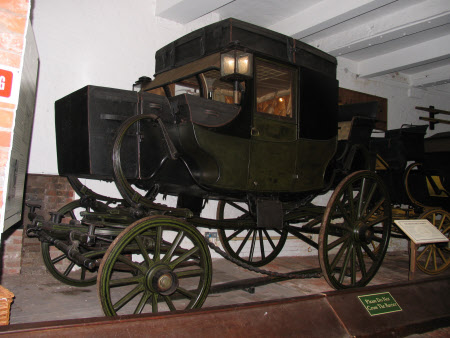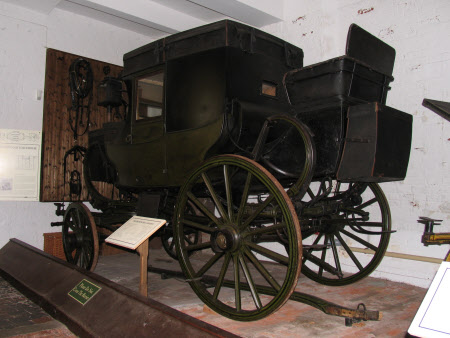Britzschka chariot
Adams and Co.
Category
Carriages & other vehicles
Date
circa 1820
Materials
Painted wood body with leather imperials, wool cloth and morocco leather upholstery and four iron shod wheels.
Measurements
269 x 425.5 x 195cm (8ft 10in x 13ft 11 1/2in x 6ft 4 3/4in)
Place of origin
Haymarket
Order this imageCollection
Shugborough Estate, Staffordshire
NT 1271499
Caption
Adams & Co were a firm who started buisness in Norwich before moving to London. They were the first coachbuilders to introduce the Britzschka to England in 1818. This type of carriage was originally of Austrian origin. Britzschkas were a sturdy travelling carriage. They were designed to be able to carry lots of luggage and have a boot that can be opened to allow the occupants to lie flat and rest on long journeys.
Summary
Britzschka Chariot built circa 1820 by Adams & Co of London. Britzschka Chariot (four wheels) for a team of horses. A Britzschka Chariot has the body of a britzschka beneath the elbow line and the body of a travelling chariot above it. This example has ogee end panels, as a classical britzschka, and it also has a dormeuse boot, to enable the occupants to lie at full length on a long journey, which has a bottom-hinged door in its front panel. The chariot is unusually complete and has two roof imperials, two boot imperials, and large cap cases attached to the front of the dormeuse boot and the back of the hind boot. The body is sprung on C and under springs. There are two lamps on the outside and one interior lamp. Upholstered in tan coloured morocco leather and cotton cloth. Painted in black and green with lighter green lining. Crest on the side panels.
Full description
A Britzschka Chariot has the body of a britzschka beneath the elbow line and the body of a travelling chariot above it. This example has ogee end panels, as a classical britzschka, and it also has a dormeuse boot, to enable the occupants to lie at full length on a long journey, which has a bottom-hinged door in its front panel. The chariot is unusually complete and has two roof imperials, two boot imperials, and large cap cases (perhaps budgets) attached to the front of the dormeuse boot and the back of the hind boot. The hind boot is permanently fitted, proving that this carriage was intended for travelling only. The travelling furniture could not be removed and replaced by town furniture so it is obvious that this carriage was never driven by a coachman. The hind boot has a rumble seat, high double seat rails and deep leather squabs to provide slight protection for the servants carried in it. It has a deep seat back fitted immediately above the seat rail. There are sockets on the seat rails to enable a folding leather head to be fitted, but this is missing. The front window is curved in profile and it has a calash (sunshade) to protect the occupants from the glare of the sun, with a similarly curved frame. George Adams was a coachbuilder in Norwich until 1826 when he moved to 28 Haymarket, London. They were the first coachbuilders to introduce the Britzschka to England in 1818. This type of carriage was originally of Austrian origin. In 1833 Adams was joined in partnership by George Hooper and the firm became Adams & Hooper until 1846. A clause in the partnership agreement stated that if either partner was absent from the business for more than a specified number of months, the other partner could buy out his share. This happened in 1846 when the firm became Hooper & Co., who later became one of the world’s most celebrated coachbuilders.
Marks and inscriptions
On front nearside axle cap.: ADAMS & COMPY. LONDON On front offside axle cap.: ADAMS & COMPY. LONDON On rear nearside axle cap.: ADAMS & COMPY. LONDON On rear offside axle cap.: ADAMS & COMPY. LONDON On the plates of the Venetian blinds.: ADAMS & Co. HAYMARKET On front nearside axle arm.: THRUPP LONDON 1829 On front offside axle arm.: THRUPP LONDON 1829 On rear nearside axle arm.: THRUPP LONDON 1829 On rear offside axle arm.: THRUPP LONDON 1829
Makers and roles
Adams and Co., coach builder
References
Apollo Annual Magazine , Christopher Nicholson ‘The Britzschka Chariot at Shugborough’ Apollo April 1993

